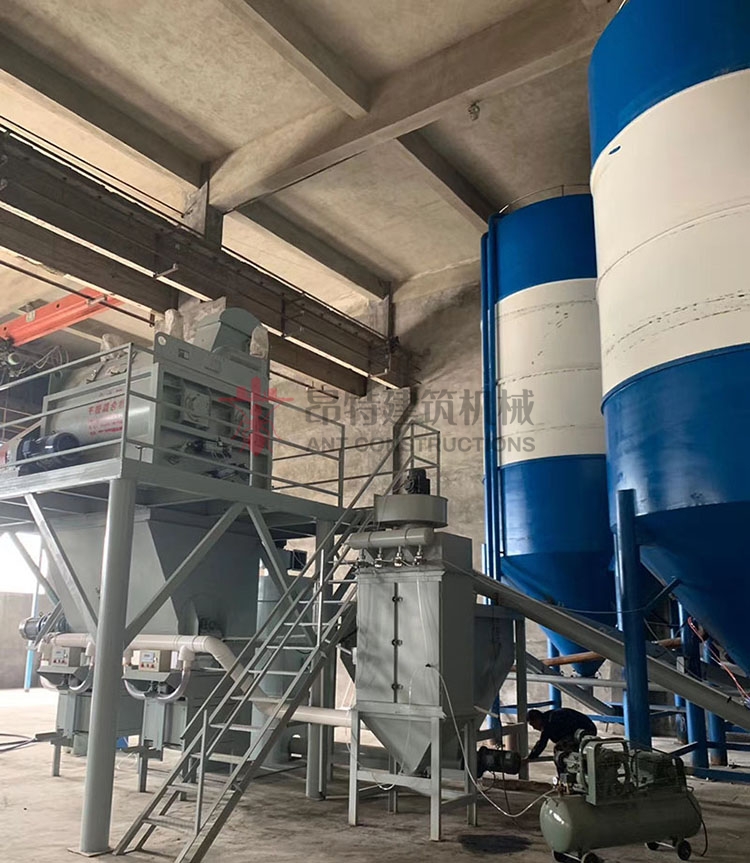What is dry mortar, classification and different application
Author:ANT CONSTRUCTIONS Comefrom: Createdate:2020/12/4 8:48:18 Hits:238
What is dry mortar, classification and different application
What is dry mortar?
Dry mortar is granular or powdered aggregate (such as quartz sand), inorganic cementing material (such as cement) and additives (such as polymer) that have been dried, screened and physically mixed in a certain proportion. It is the material that can be used directly after being transported to the construction site in the form of bags or bulk tank, and can be directly used by mixing with water. It is also called dry powder mortar, dry-mix mortar, and dry-mix powder. Some construction adhesives also belong to this category. Dry mortar is used as a thin layer to play the role of bonding, liner, protection and decoration in the construction industry, and it is widely used in construction and decoration projects.
How to classify the dry mortar and it's application respectively?
Dry-mixed masonry mortar: code number DM;
Wet-mixed masonry mortar: code name WM.
According to the water absorption characteristics of different masonry materials, dry-mixed masonry mortar can be divided into:
High water retention masonry mortar: code DM-HR, used for aerated concrete blocks and sintered bricks;
Medium water retention masonry mortar: code DM-MR, used for ordinary concrete blocks and lightweight concrete blocks;
Low water retention masonry mortar: code DM-LR, used for lime-sand bricks.
According to the common strength of masonry mortar, it is divided into: DM-5; DM-7.5; DM-10; DM-15; DM-20; DM-25; DM-30. Testing standard: JGJ/T70-2009
Plastering mortar: code P;
Dry-mix plastering mortar: code DP;
Wet-mixed plastering mortar: code WP;
Dry-mixed plastering mortar can be divided into:
High water retention plaster mortar: code DP-HR, used for aerated concrete walls and sintered brick walls;
Medium water retention plastering mortar: code DP-MR, used for ordinary concrete block and lightweight concrete block wall, lightweight concrete slat wall, cast-in-place concrete wall;
Low water retention plastering mortar: code DP-LR, used for lime-sand brick walls.
According to the thickness of plastering mortar, it can be divided into:Thin layer plastering mortar: code DP
According to the commonly used strength marks of plaster mortar, it is divided into: DP-5; DP-10; DP-15; DP-20. Testing standard: JGJ/T70-2009
Ground leveling mortar: code S;
Dry-mix floor leveling mortar: Code DS; Test standard: JGJ/T70-2009
Wet mixed floor leveling mortar: code WS; testing standard: JGJ/T70-2009
Cement-based self-leveling mortar: code SLF; test standard: JCT 985-2005
Gypsum-based self-leveling mortar: code SLF-G.
Polystyrene board thin plaster external wall external thermal insulation system special dry-mix adhesive mortar: code DEA;
Polystyrene board thin plaster exterior wall exterior insulation system special dry-mix plastering mortar: code DBI;Testing standard: JG 149-2003
Tile bonding mortar: code DTA;
Tile grout: code DTG. Testing standard: JCT 547-2005
Interface treatment agent: code DB. Testing standard: JC/T 907-2002
Dry-mixed polymer cement waterproof mortar. Testing standard: JC/T 984-2011
Dry-mix wear-resistant floor mortar. Testing standard: JC/T 906
Dry mixed facing decorationmortar. Testing standard: JC/T 1024
According to the composition material, ordinary mortar can be classified as below methods:
Lime mortar. It is made of lime paste, sand and water according to a certain ratio, and is generally used for masonry and plastering layers with low strength and low moisture requirements;
Cement mortar. It is made of cement, sand and water according to a certain ratio, and is generally used for masonry, walls or floors in humid environments or water;
Mixed mortar. The cement or lime mortar is mixed with appropriate admixtures such as fly ash, diatomaceous earth, etc. to save the amount of cement or lime and improve the workability of the mortar. Commonly used mixed mortars include cement lime mortar, cement clay mortar and lime clay mortar.
According to different purposes, it is divided into: masonry mortar, plastering mortar (including decorative mortar, waterproof mortar), etc. The strength of masonry mortar is expressed by strength grade. Mortar strength grade is a cube test block with a side length of 70.7mm. Under standard curing conditions (temperature (20±2)℃, relative humidity above 95%), the compressive strength of 28d is measured by standard test methods The value (in MPa) is determined. Masonry mortar is divided into six strength grades: M20, M15, M10, M7.5, M5, and M2.5 according to the compressive strength. In general, M2.5-M15 masonry mortar is used for the walls of multi-storey buildings; masonry foundations, inspection wells, rain wells and other masonry are often used M5 mortar; industrial plants, substations, basements and other masonry M2.5-M10 masonry mortar is used; mortars below M2.5 are commonly used for buildings below two floors; lime mortar can be used for simple bungalows and temporary buildings; general highway construction drains use M7.5 strength grade masonry mortar.








